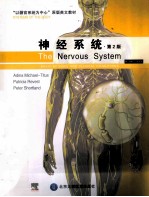图书介绍
“以器官系统为中心”系列教材 神经系统PDF|Epub|txt|kindle电子书版本网盘下载

- 阿蒂那·米歇尔-提图斯等著 著
- 出版社: 北京:北京大学医学出版社
- ISBN:9787565901126
- 出版时间:2011
- 标注页数:333页
- 文件大小:160MB
- 文件页数:343页
- 主题词:神经系统疾病-医学院校-教材-英文
PDF下载
下载说明
“以器官系统为中心”系列教材 神经系统PDF格式电子书版下载
下载的文件为RAR压缩包。需要使用解压软件进行解压得到PDF格式图书。建议使用BT下载工具Free Download Manager进行下载,简称FDM(免费,没有广告,支持多平台)。本站资源全部打包为BT种子。所以需要使用专业的BT下载软件进行下载。如BitComet qBittorrent uTorrent等BT下载工具。迅雷目前由于本站不是热门资源。不推荐使用!后期资源热门了。安装了迅雷也可以迅雷进行下载!
(文件页数 要大于 标注页数,上中下等多册电子书除外)
注意:本站所有压缩包均有解压码: 点击下载压缩包解压工具
图书目录
1 ORGANIZATION OF THE NERVOUS SYSTEM1
Introduction2
Overview of brain anatomy2
Internal anatomy of the brain5
Ventricular system10
Forebrain11
Hemisphere specialization12
Limbic system14
Orbitofrontal cortex17
Basal ganglia17
Diencephalon17
Thalamus18
Hypothalamus19
Peripheral nervous system21
Putting it all together:from anatomy to behaviour29
2 ELEMENTS OF CELLULAR AND MOLECULAR NEUROSCIENCE31
Introduction32
Neurones32
Glial cells34
Neurone excitability35
Neurotransmitters41
Postsynaptic events and postsynaptic receptors42
3 CLINICAL EXAMINATION47
Introduction48
Parts of the clinical examination48
Other investigations55
General comments57
4 THE SPINAL CORD59
Introduction60
Gross anatomy of the spinal cord and vertebral column60
Functional organization of the spinal cord61
Spinal cord cell types63
Receptive fields64
Somatosensory pathways65
Blood supply to the spinal cord71
Damage to the spinal cord72
Comments on the case history78
5 PAIN AND ANALGESIA79
Introduction80
Nociceptors81
Pain pathways82
How does the central nervous system interpret a stimulus as painful?84
Physiology of pain modulation86
Pain mechanisms after tissue damage:peripheral and central sensitization90
Neuropathic pain mechanisms92
Pharmacology of pain93
Other approaches to pain management99
General comments on pain management104
6 CRANIAL NERVES AND THE BRAINSTEM105
Introduction106
Anatomical organization of cranial nerves in the brain106
Internal organization of the brainstem107
Reticular formation109
Blood supply to the brainstem112
Brainstem reflexes112
Brainstem lesions116
Comments on the case history118
7 THE VISUAL SYSTEM121
Introduction122
Structure of the eye122
Visual pathways125
Visual field defects127
Pupillary light reflexes127
Focusing of light on the retina127
Control of eye movements130
Structure and function of the retina131
Processing of visual information137
Summary140
8 HEARING AND BALANCE:THE AUDITORY AND VESTIBULAR SYSTEMS141
Introduction142
The auditory system142
The vestibular system152
Comments on the case history158
9 MOTOR SYSTEMS Ⅰ:DESCENDING PATHWAYS AND CEREBELLUM159
Introduction160
Skeletal muscle contraction161
Reflexes164
Descending pathways167
Clinical importance of reflexes172
The cerebellum175
10 MOTOR SYSTEMS Ⅱ:THE BASAL GANGLIA181
Introduction182
The basal ganglia:structure and organization182
Parkinson's disease184
Huntington's disease194
11 STROKE AND HEAD INJURY199
Introduction200
Physiological control of cerebral blood flow200
Blood supply to the brain201
Venous system204
Functional anatomy of the cerebral vasculature205
Angiography206
Stroke206
Head injury219
Comments on the case history225
12 INFECTION IN THE CENTRAL NERVOUS SYSTEM227
Introduction228
Types of infection of the central nervous system228
The meninges229
Cerebrospinal fluid production and circulation230
The blood-brain barrier232
Meningitis232
Diagnosis and treatment of meningitis234
Treatment of meningitis235
Encephalitis235
Cerebral abscesses235
Brain infections in the immunocompromised patient236
13 EPILEPSY237
Introduction238
General description of epilepsy238
Epidemiology of epilepsy238
Types of epileptic syndrome239
Diagnostic investigations of epilepsy239
Different types of seizure242
Neurobiology of epilepsy243
Pharmacological treatment of epilepsy246
Other treatments for epilepsy248
Treatment of status epilepticus249
Social consequences of epilepsy249
14 DEMENTIA251
Introduction252
Causes and diagnosis of dementia252
Neurobiology of learning and memory253
Alzheimer's disease256
Treatment of Alzheimer's disease261
Other types of dementia263
General considerations in the management of Alzheimer's disease and other types of dementia265
15 SCHIZOPHRENIA267
Introduction268
Schizophrenia:the clinical diagnosis268
Aetiology of schizophrenia271
Neurobiology of schizophrenia272
Treatment of schizophrenia275
Comments on the management of schizophrenia and the long-term prognosis278
Other psychoses and schizophrenia-like syndromes279
16 DEPRESSION AND ANXIETY281
Introduction282
Classification of mood disorders282
Clinical features of mood disorders282
Epidemiology of depression and natural evolution of the disease283
Genetics of mood disorders283
Neurobiology of depression286
Treatment of depression287
Bipolar disorder and its treatment292
General comments on mood disorders293
Need for new therapeutic targets294
Comments on the case history294
Anxiety disorders294
Treatment of anxiety disorders295
Insomnia297
17 ADDICTION301
Introduction302
Addiction and drug misuse:general comments302
Opiates302
Cocaine and crack304
Cannabis305
Nicotine307
Alcohol308
Phencyclidine309
Amphetamines310
Ecstasy-or the beginning of agony?310
Hallucinogens311
Solvents311
Neurobiology of addiction312
Addiction and rehabilitation:general issues313
Index315